Site Effect Assessment in Ulaanbaatar, Mongolia through Inversion Analysis of Microtremor H/V Spectral Ratios
Abstract
1. Introduction
2. Previous Studies for Site Characterizations in UB
3. Microtremor Observations
4. Inversion Analysis of Microtremor Data
4.1. Joint Inversion of H/V Spectral Ratio and Surface Wave Dispersion Curve
4.2. Single Inversion of H/V Spectral Ratio
4.3. Comparison with Borehole Data
4.4. VS30 Distribution in UB.
5. Site Effect Assessment
6. Conclusions
Author Contributions
Funding
Acknowledgments
Conflicts of Interest
References
- Adiya, M. Seismic Activity Near Ulaanbaatar: Implication for Seismic Hazard Assessment. Ph.D. Thesis, University of Strasbourg, Strasbourg, France, 2016. [Google Scholar]
- Oyun-Erdene, M.; Odonbaatar, C.; Ganzorig, D. Predicting strong ground motion of Emeelt fault. Sci. Acad. News 2014, 2, 48–56. (In Mongolian) [Google Scholar]
- Odonbaatar, C. Site effects characterization in the basin of Ulaanbaatar. Ph.D. Thesis, University of Strasbourg, Strasbourg, France, 2011. [Google Scholar]
- Dzurick, V.I.; Kluchevskii, A.I.; Serebnikov, S.P.; Demiyanovich, B.M.; Batsaikhan, T.; Bayaraa, G. Seismicity and Seismic Hazard Zoning of Mongolian Region; Earth’s Crust Institute: Irkutsk, Russia, 2009. [Google Scholar]
- The Government of Ulaanbaatar City, Japan International Cooperation Agency (JICA) and Emergency Management Department of the Capital City. Report of Mongolia “The Project for Strengthening the Capacity of Seismic Disaster Risk Management in Ulaanbaatar City”. Available online: http://open_jicareport.jica.go.jp/pdf/12129110_01.pdf (accessed on 11 April 2019).
- Nakamura, Y. A method for dynamic characteristics estimation of the subsurface using microtremor on the ground surface. Q. Rep. RTRI 1989, 30, 25–33. [Google Scholar]
- Lermo, J.; Chavez-Garcia, F.J. Are microtremors useful in site response evaluation? Bull. Seismol. Soc. Am. 1994, 84, 1350–1364. [Google Scholar]
- Lachet, C.; Bard, P.-Y. Numerical and theoretical investigations of the possibilities and limitations of Nakamura’s technique. J. Phys. Earth 1994, 42, 377–397. [Google Scholar] [CrossRef]
- Arai, H.; Tokimatsu, K. S-wave velocity profiling by inversion of microtremor H/V spectrum. Bull. Seismol. Soc. Am. 2004, 94, 53–63. [Google Scholar] [CrossRef]
- Arai, H.; Tokimatsu, K. S-wave velocity profiling by joint inversion of microtremor dispersion curve and horizontal-to-vertical (H/V) spectrum. Bull. Seismol. Soc. Am. 2005, 95, 1766–1778. [Google Scholar] [CrossRef]
- Sánchez-Sesma, F.J.; Weaver, R.L.; Kawase, H.; Matsushima, S.; Luzon, F.; Campillo, M. Energy partitions among elastic waves for dynamic surface loads in a semi-infinite solid. Bull. Seismol. Soc. Am. 2011, 101, 1704–1709. [Google Scholar] [CrossRef]
- Sánchez-Sesma, F.J.; Rodríguez, M.; Iturrarán-Viveros, U.; Luzón, F.; Campillo, M.; Margerin, L.; Rodríguez-Castellanos, A. A theory for microtremor H/V spectral ratio: Application for a layered medium. Geophys. J. Int. 2011, 186, 221–225. [Google Scholar] [CrossRef]
- García-Jerez, A.; Piña-Flores, J.; Sánchez-Sesma, F.J.; Luzón, F.; Perton, M. A computer code for forward calculation and inversion of the H/V spectral ratio under the diffuse field assumption. Comput. Geosci. 2016, 97, 67–78. [Google Scholar] [CrossRef]
- Piña-Flores, J.; Perton, M.; García-Jerez, A.; Carmona, E.; Luzón, F.; Molina-Villegas, J.C.; Sánchez-Sesma, F.J. The inversion of spectral ratio H/V in a layered system using the diffuse field assumption (DFA). Geophys. J. Int. 2017, 208, 577–588. [Google Scholar] [CrossRef]
- Sánchez-Sesma, F.J. Modeling and inversion of the microtremor H/V spectral ratio: Physical basis behind the diffuse field approach. Earth Planets Space 2017, 69, 92. [Google Scholar] [CrossRef]
- Kawase, H.; Mori, Y.; Nagashima, F. Difference of horizontal-to-vertical spectral ratios of observed earthquakes and microtremors and its application to S-wave velocity inversion based on the diffuse field concept. Earth Planet Space 2018, 70, 1. [Google Scholar] [CrossRef]
- Fujishima, D.; Miura, H.; Kanno, T.; Shigefuji, M.; Abiru, T.; Nakamura, H.; Aoi, S. Estimation accuracy of shear wave velocity profiles inverted from earthquake and microtremor H/V spectral ratios. In Proceedings of the 15th Japan Earthquake Engineering Symposium, Sendai, Japan, 6–8 December 2018; pp. 2141–2149, (In Japanese with English abstract). [Google Scholar]
- Orkhon Hydrogeology Co. Ltd. Engineering geological map of Ulaanbaatar; Ministry of Construction of Mongolia: Ulaanbaatar, Mongolia, 2014.
- Kitsunezaki, C.; Goto, N.; Kobayashi, Y.; Ikawa, T.; Horike, M.; Saito, T.; Kurota, T.; Yamane, K.; Okuzumi, K. Estimation of P and S-wave velocities in deep soil deposits for evaluating ground vibrations in earthquake. J. Nat. Dis. Sci. 1990, 9, 1–17, (In Japanese with English abstract). [Google Scholar]
- Kirkpatricks, S.; Gelatt, C.D., Jr.; Vecchi, M.P. Optimization by simulated annealing. Science 1983, 220, 671–680. [Google Scholar] [CrossRef] [PubMed]
- Haskell, N.A. Crustal reflection of plane SH-waves. J. Geophys. Res. 1960, 65, 4147–4150. [Google Scholar] [CrossRef]
- Danielson, J.J.; Gesch, D.B. Global Multi-Resolution Terrain Elevation Data 2010 (GMTED2010). Available online: https://pubs.usgs.gov/of/2011/1073/pdf/of2011-1073.pdf (accessed on 11 April 2019).
- Building Seismic Safety Council (BSSC). NEHRP Recommended Seismic Provisions for New Buildings and other Structures, Part 1 (Provisions) and Part 2 (Commentary to ASCE/SEI 7); Federal Emergency Management Agency: Washington, DC, USA, 2009.
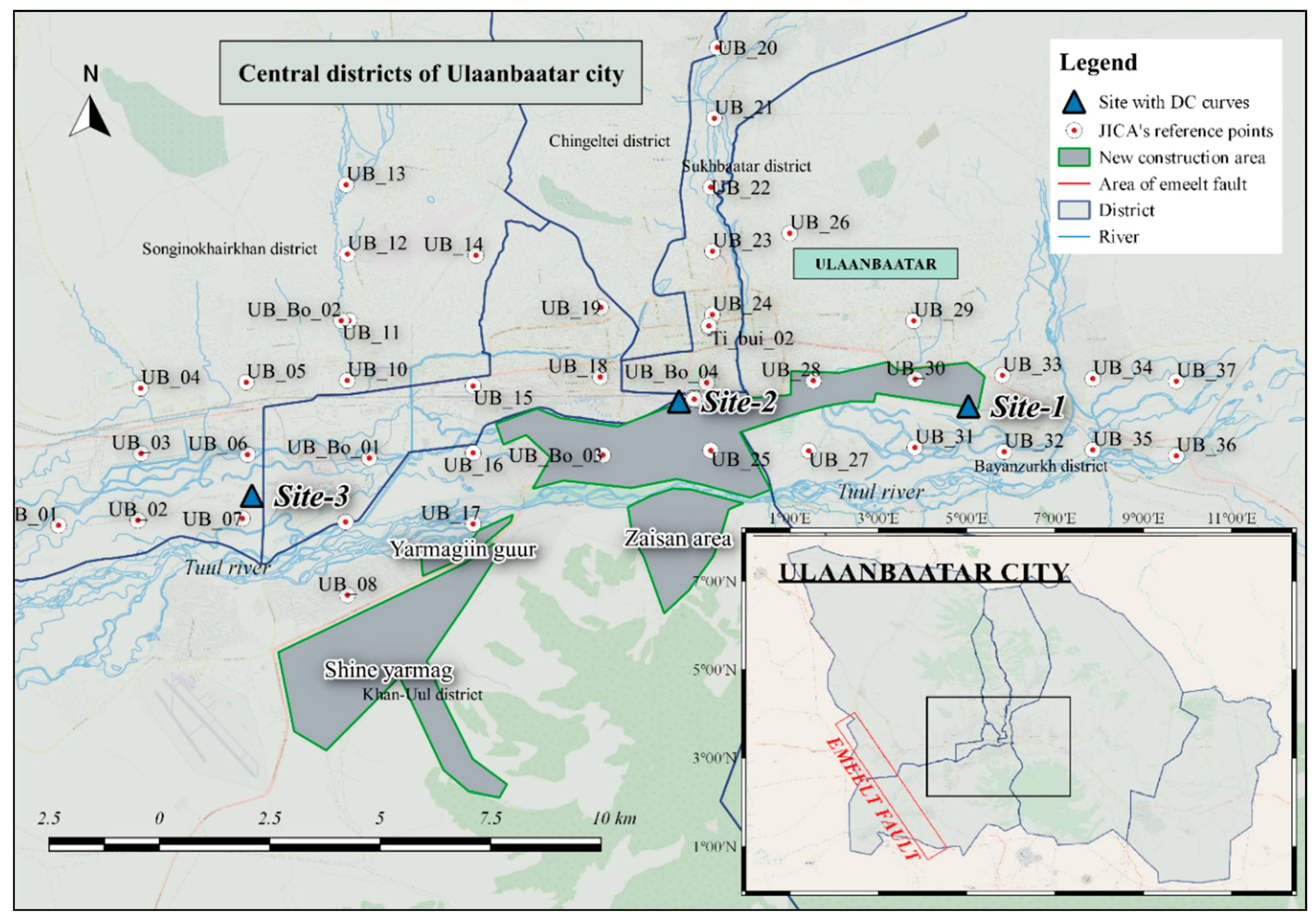
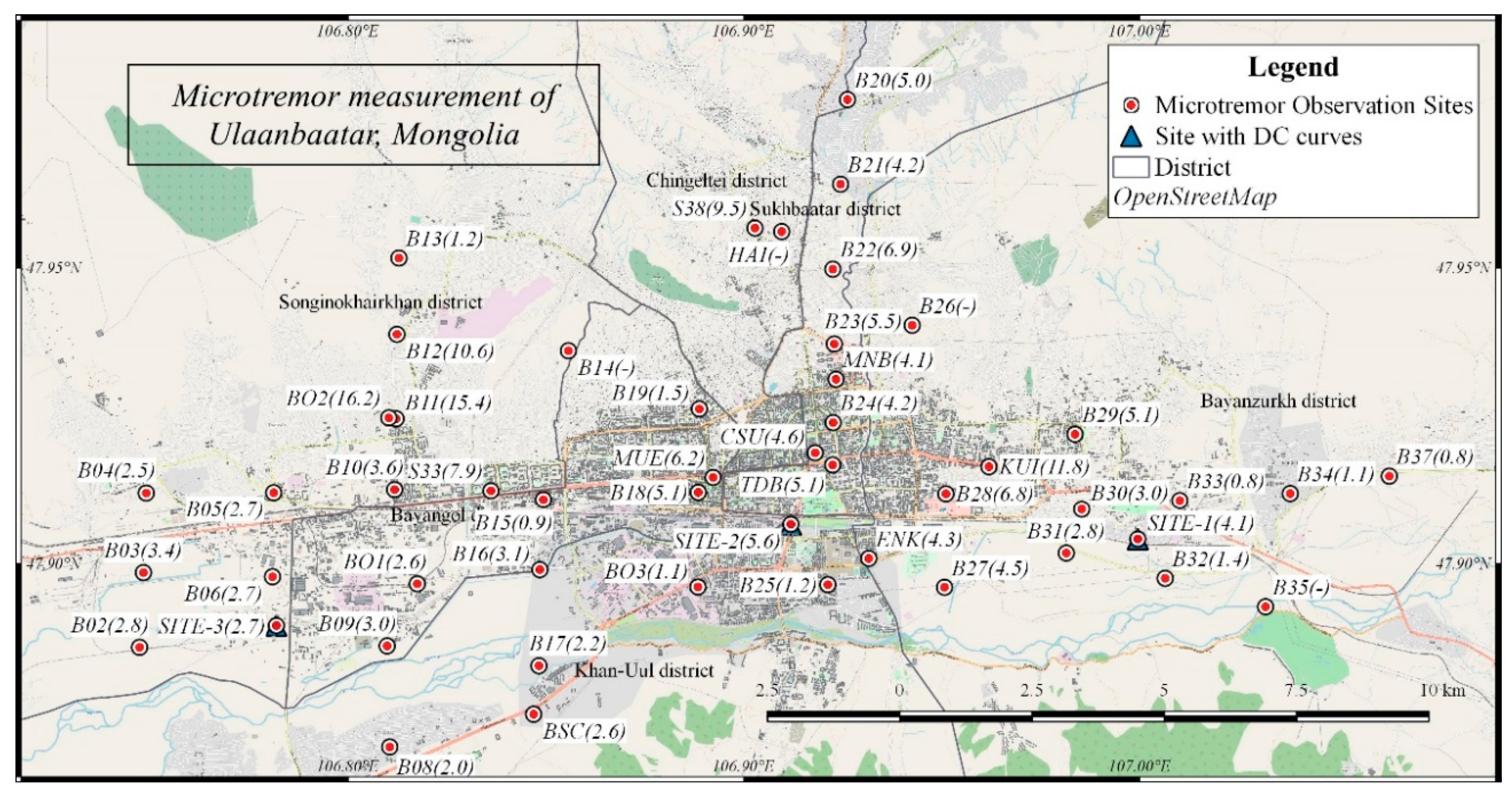
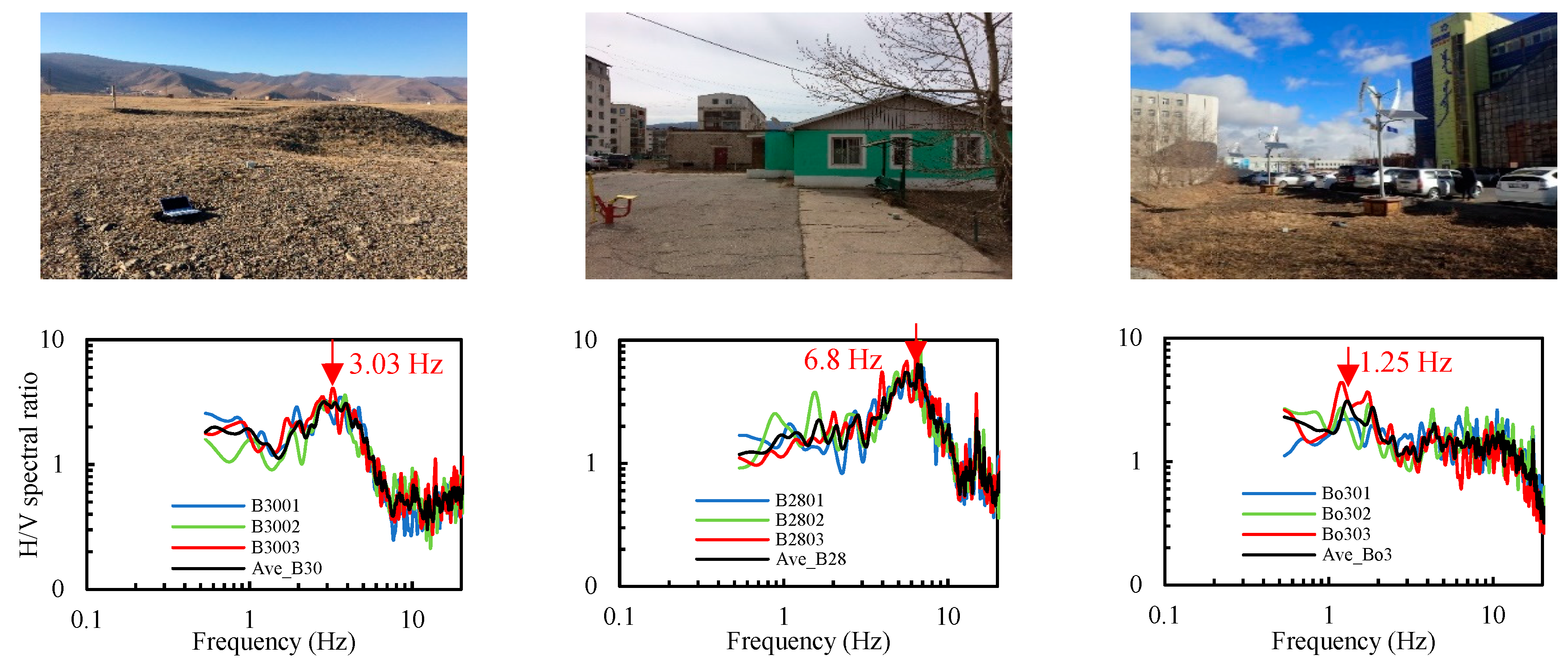
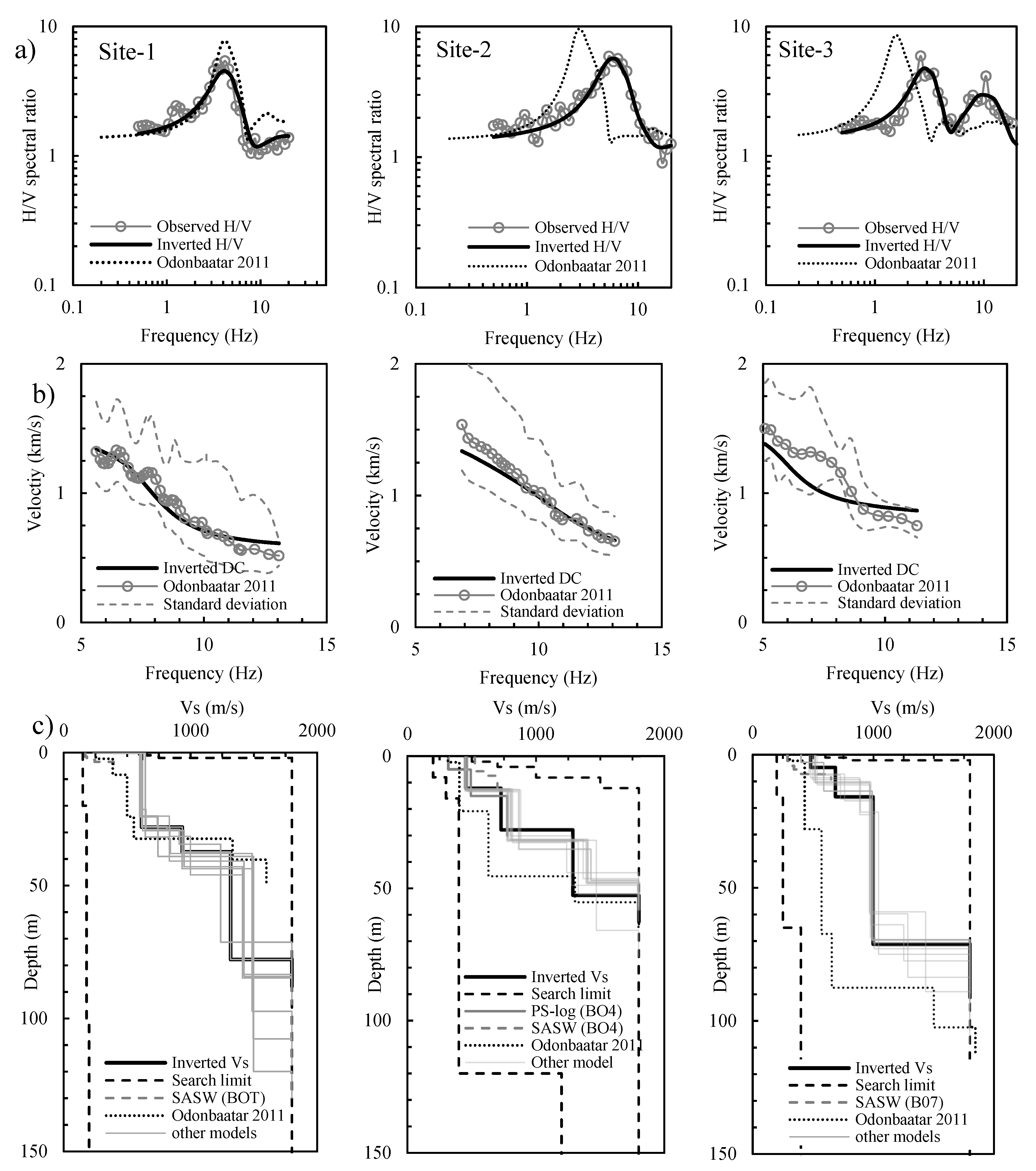
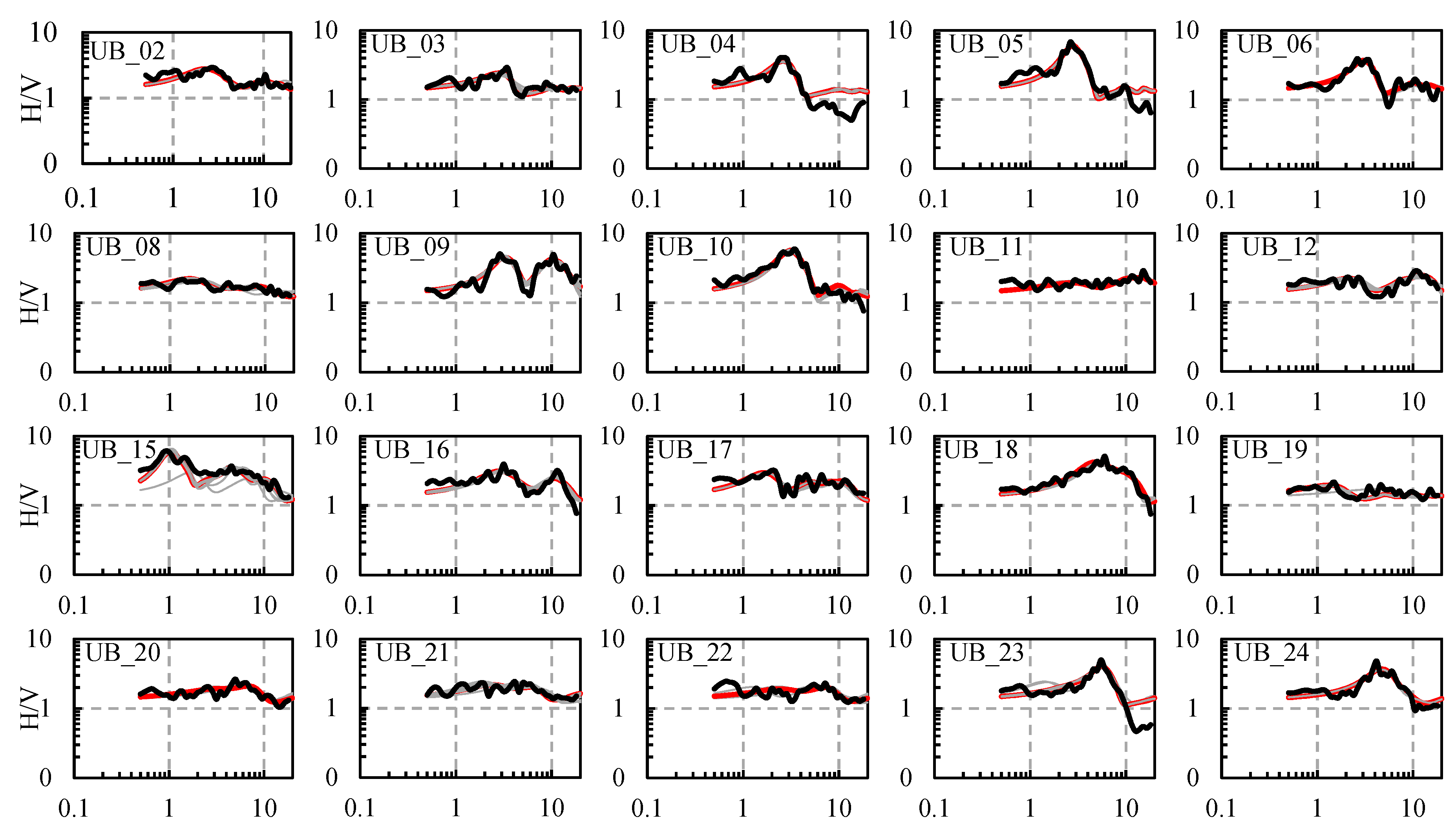

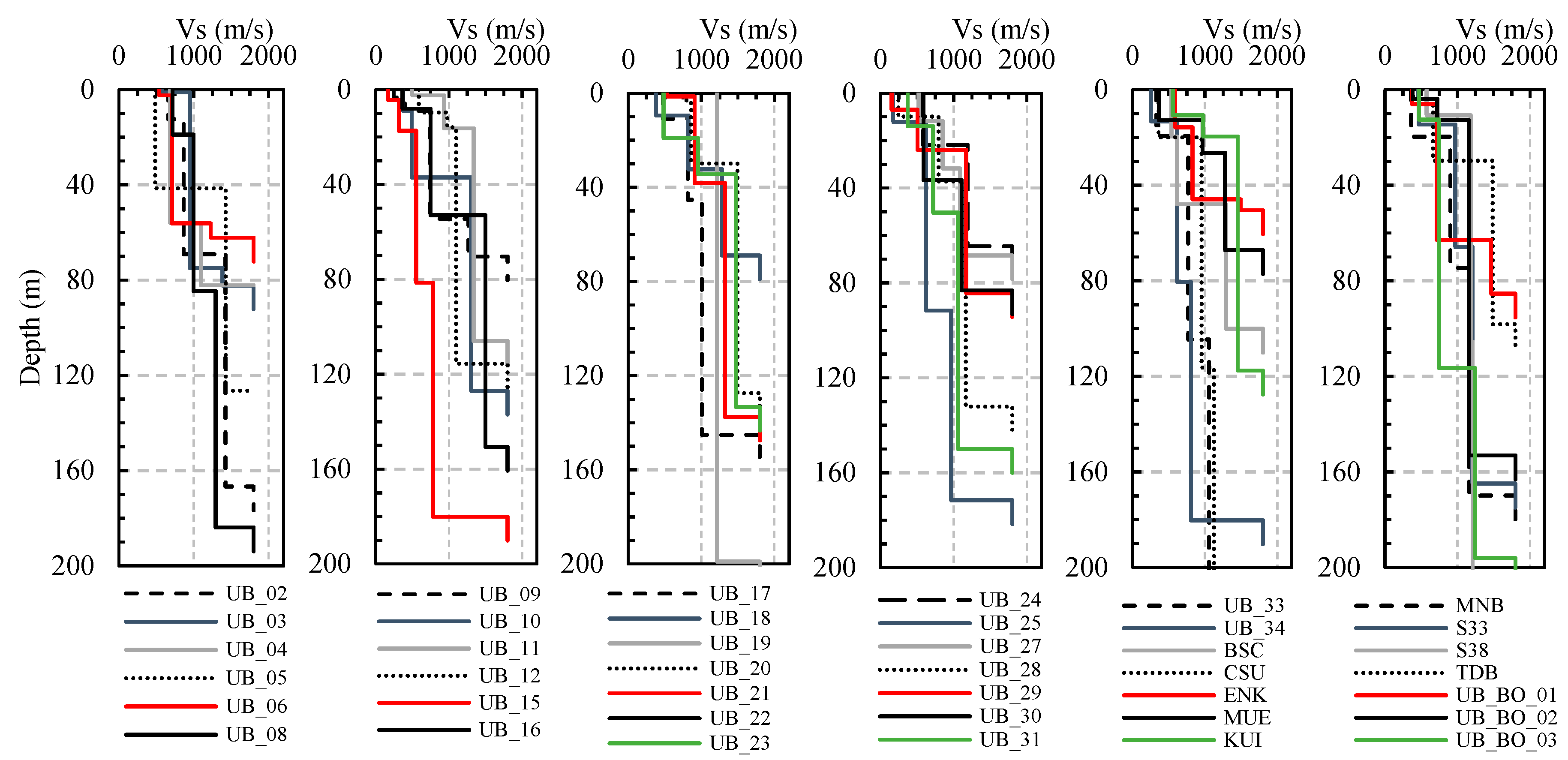
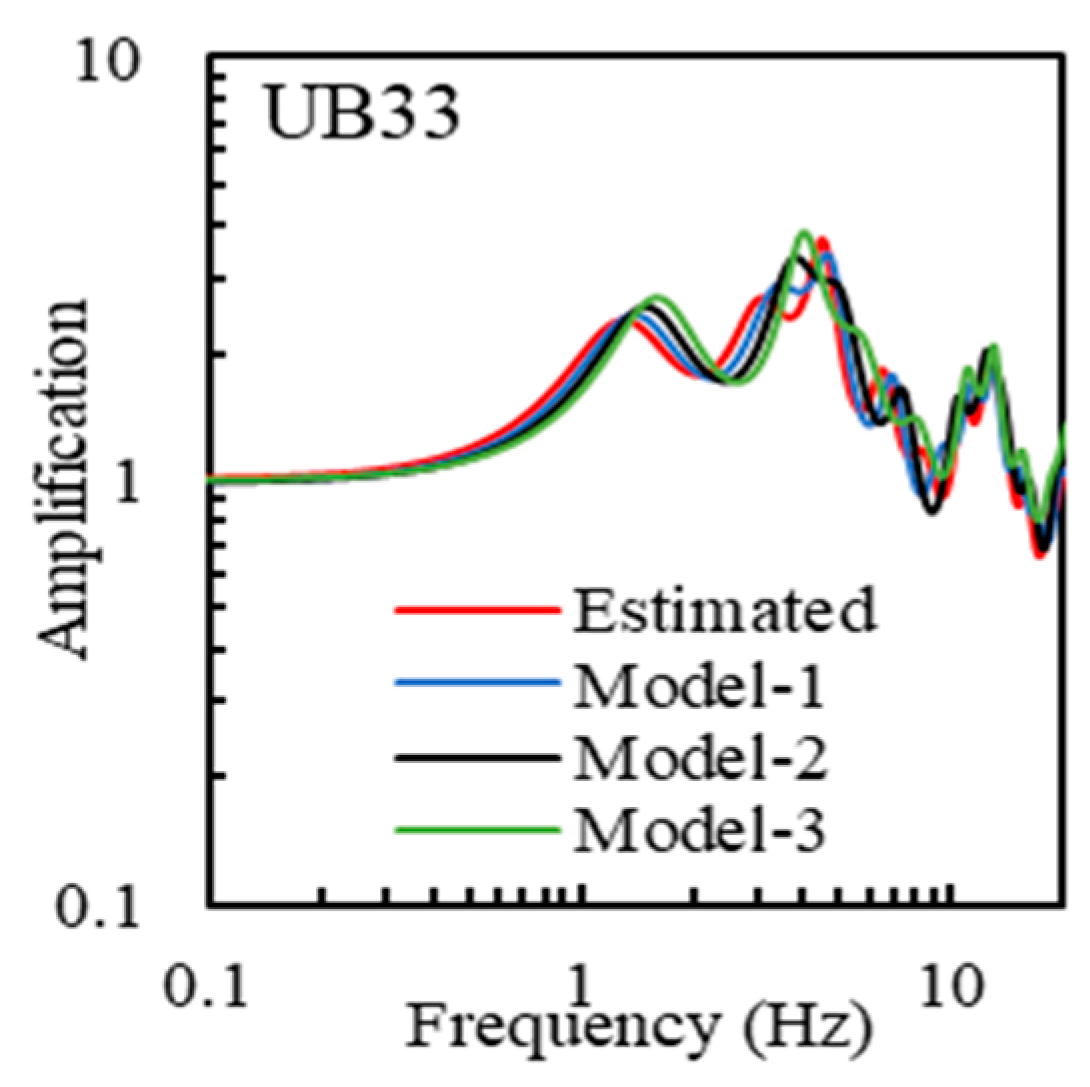
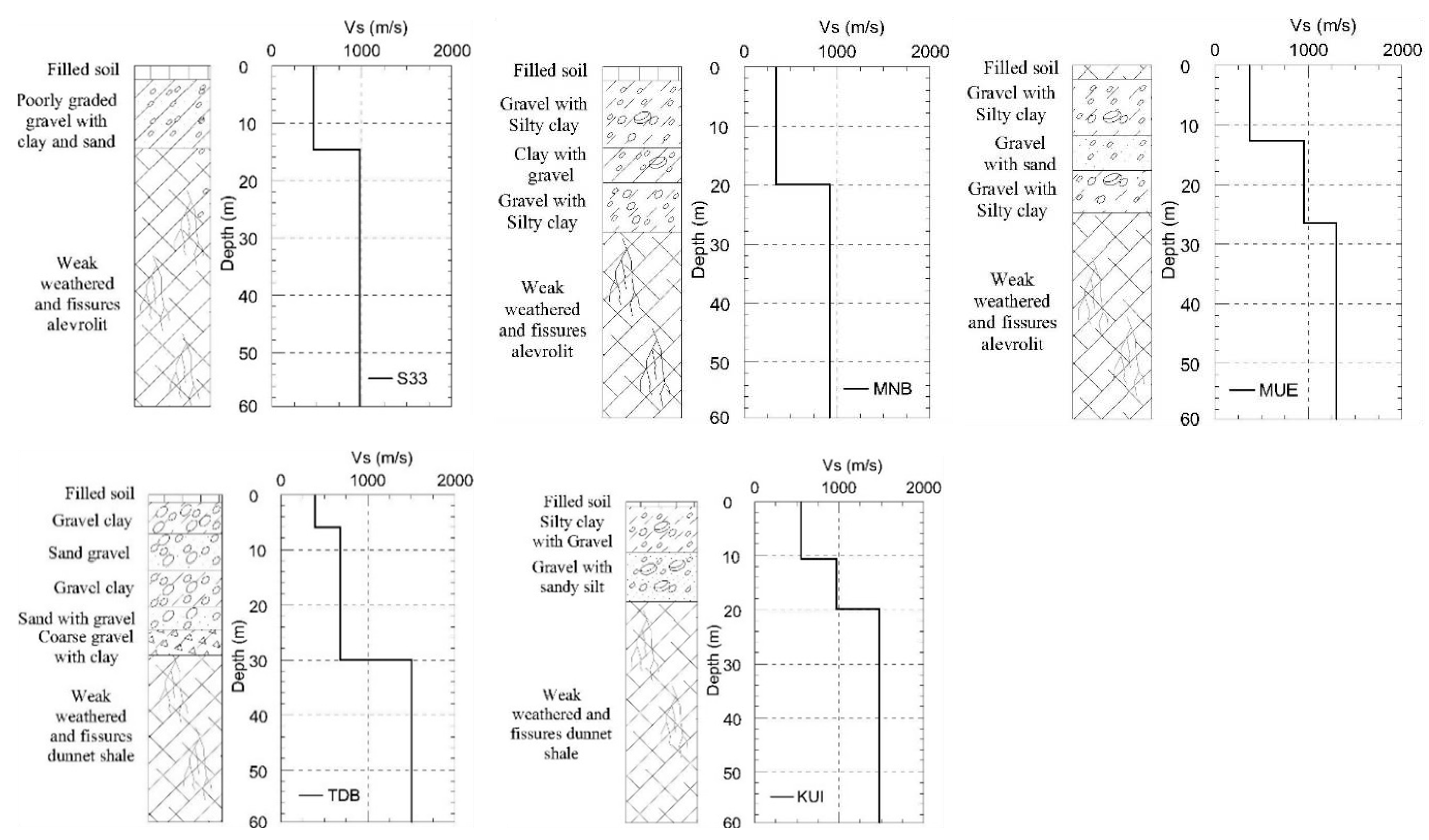
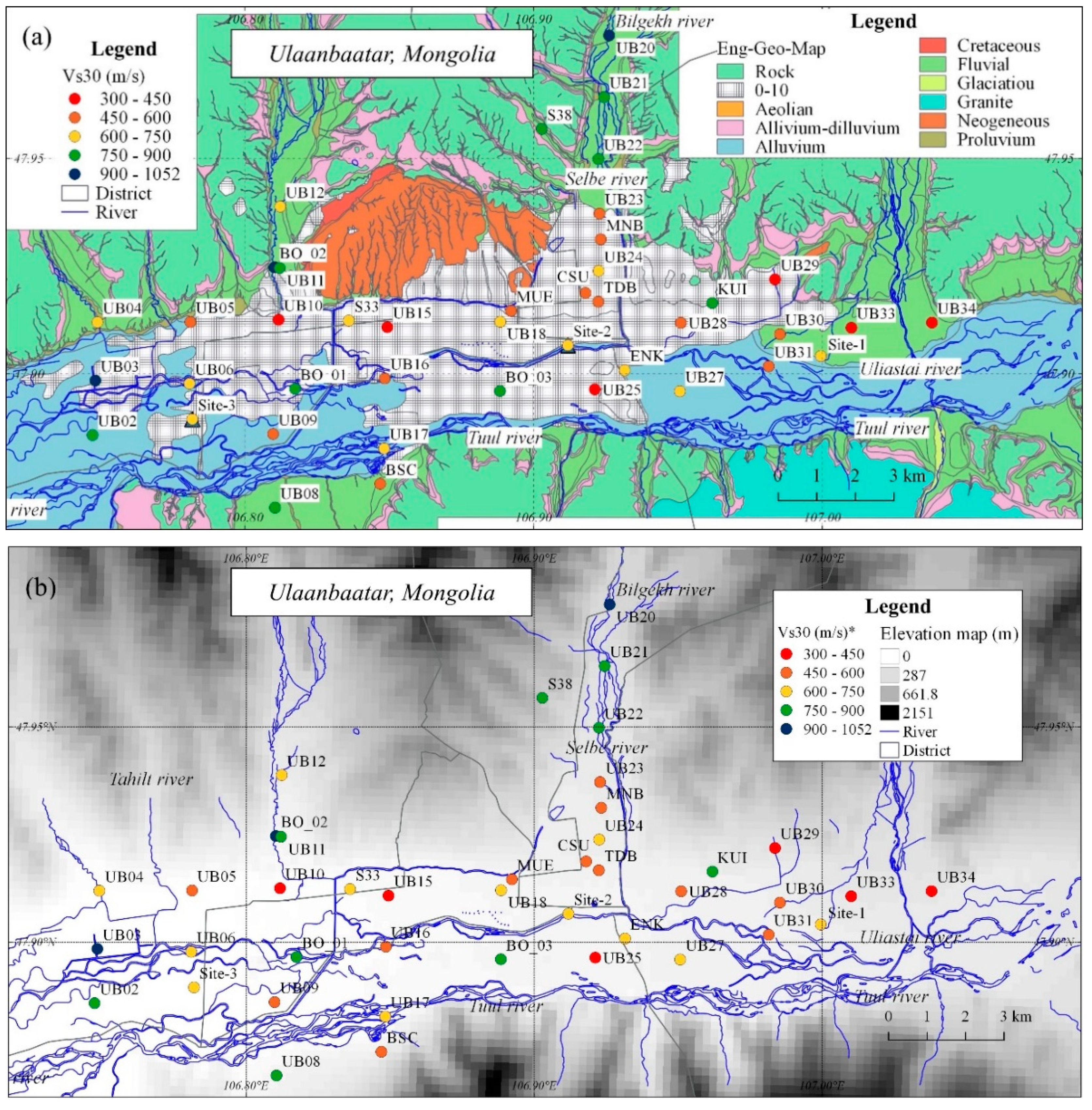
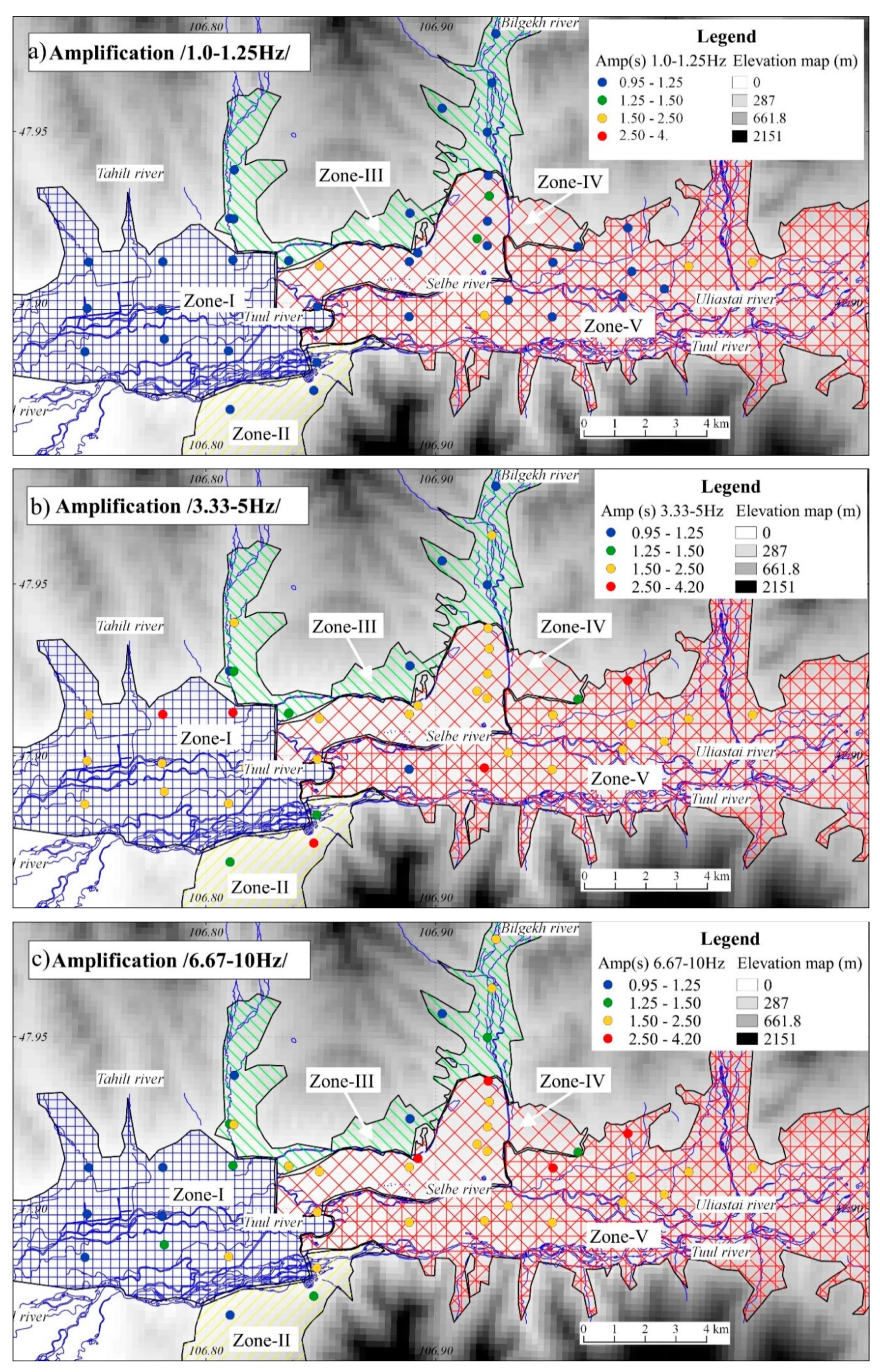
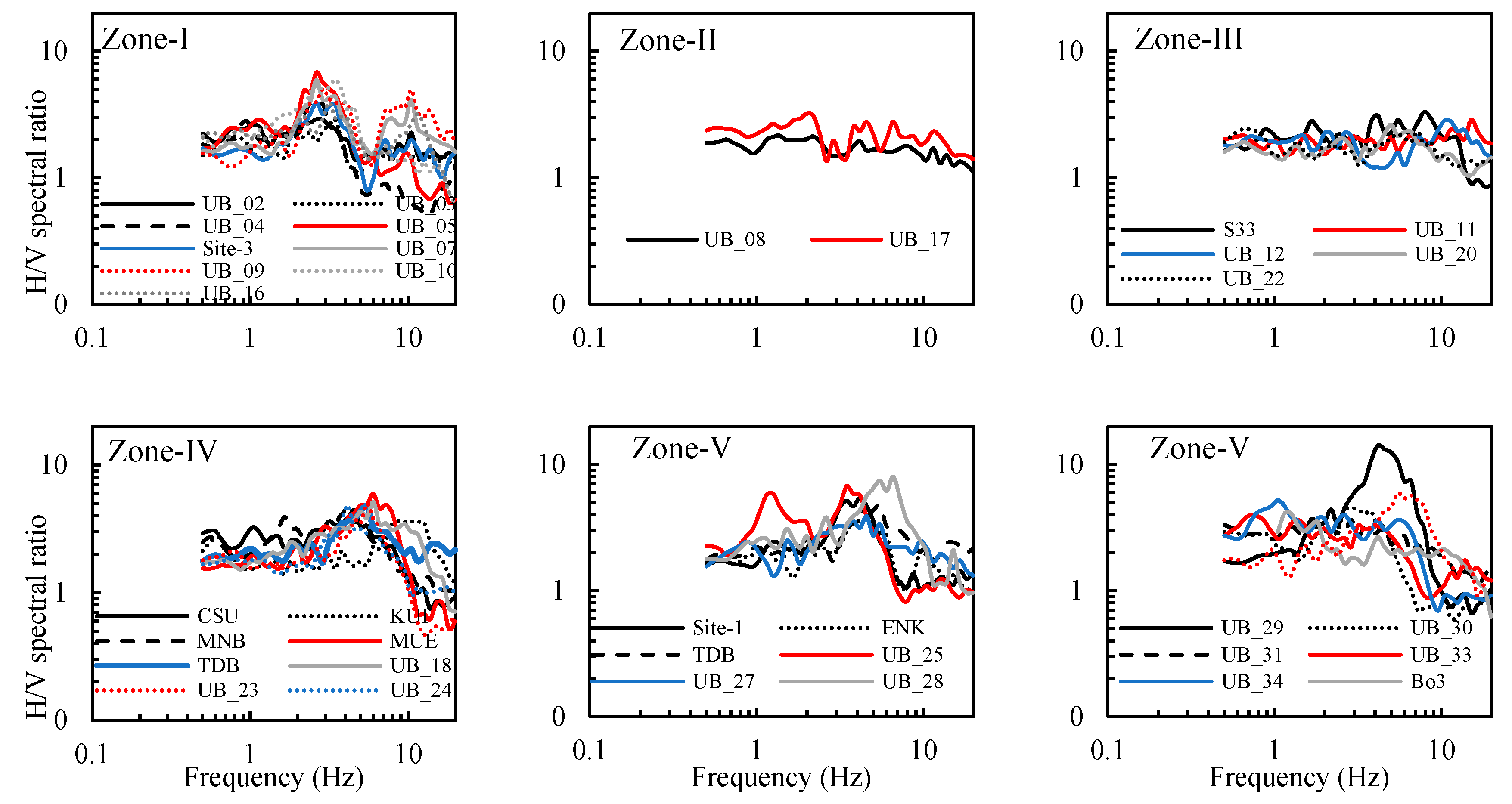
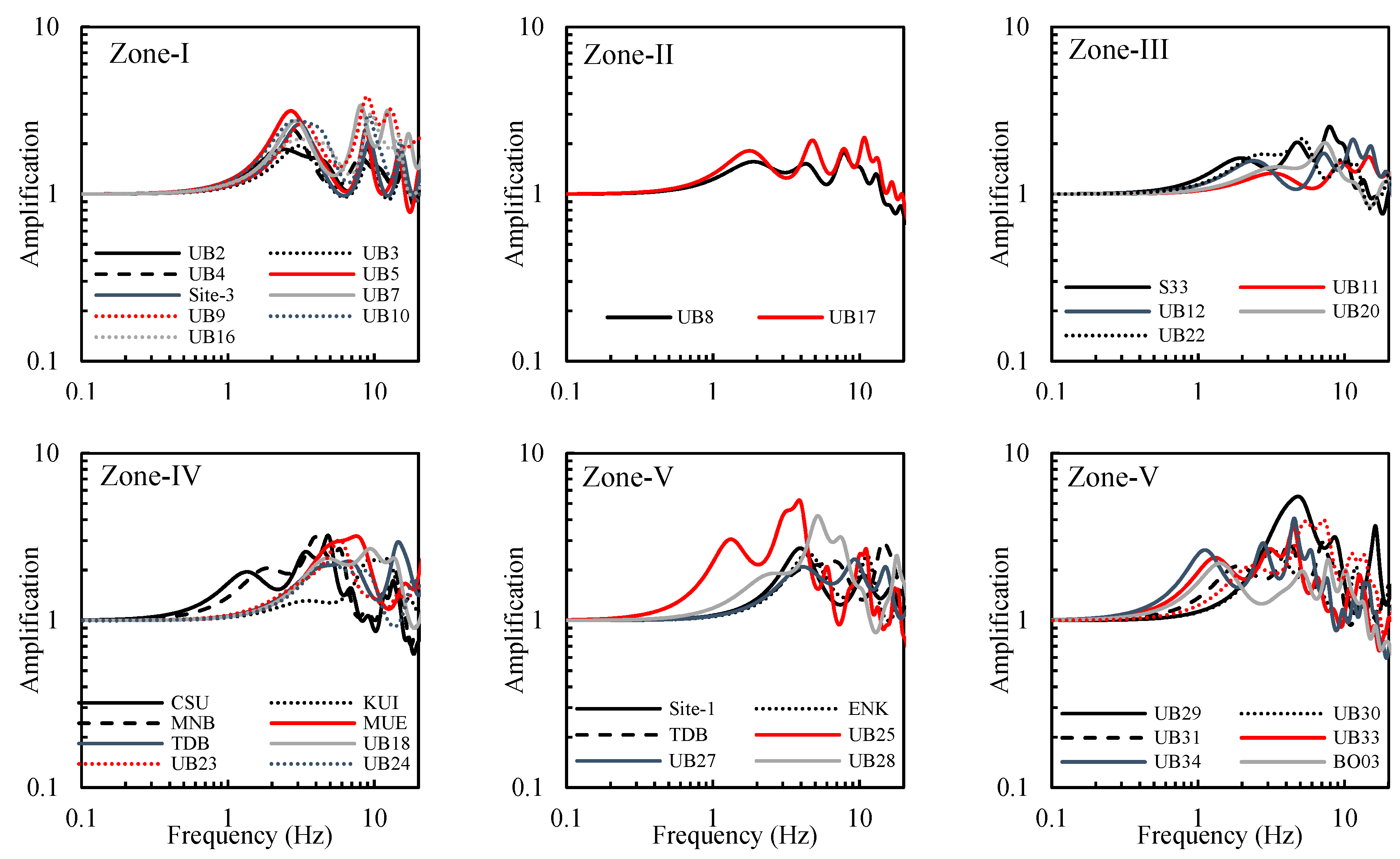

| Layer | Thickness (m) | VS (m/s) | VP (m/s) | Density (kg/m3) |
|---|---|---|---|---|
| 1 | 0–20 | 200–600 | 350–1400 | 1600–1800 |
| 2 | 0–80 | 250–800 | 450–2400 | 1700–1900 |
| 3 | 0–100 | 400–1200 | 830–2600 | 1800–2000 |
| 4 | 0–100 | 1200–1500 | 2600–2950 | 1900–2100 |
| 5 | - | 1800 | 3280 | 2000–2200 |
| Layer | Thickness (m) | VS (m/s) | VP (m/s) | Density (kg/m3) |
|---|---|---|---|---|
| 1 | 2–8 | 200–500 | 360v1120 | 1600–1800 |
| 2 | 2–8 | 300–700 | 580–1790 | 1700–1900 |
| 3 | 4–104 | 400–1000 | 830–2400 | 1800–2000 |
| 4 | 4–100 | 1200–1500 | 2620–2950 | 1900–2100 |
| 5 | - | 1800 | 3280 | 2000-2200 |
| Layer | Thickness (m) | VS (m/s) | VP (m/s) | Density (kg/m3) |
|---|---|---|---|---|
| 1 | 2–8 | 160–600 | 280–1400 | 1600–1800 |
| 2 | 2–8 | 300–700 | 580–1790 | 1700–1900 |
| 3 | 4–104 | 400–1000 | 830–2400 | 1800–2000 |
| 4 | 4–100 | 1200–1500 | 2600–2950 | 1900–2100 |
| 5 | - | 1800 | 3280 | 2000–2200 |
| JICA’s Report | This Study | |||
|---|---|---|---|---|
| Layer | Thickness (m) | VS (m/s) | Thickness (m) | VS (m/s) |
| 1 | 0–4 | 207–323 | 0–20 | 150–500 |
| 2 | 0–6 | 436–703 | 0–50 | 180–1000 |
| 3 | - | - | 0–100 | 600–1500 |
| 4 | - | - | - | 1800 |
| № | Estimated | Model-1 | Model-2 | Model-3 | |
|---|---|---|---|---|---|
| VS (m/s) | Thickness (m) | Thickness (m) | Thickness (m) | Thickness (m) | |
| 1 | 327.7 | 19.4 | 19.4 | 19.4 | 19.4 |
| 2 | 769.2 | 85.2 | 85.2 | 85.2 | 85.2 |
| 3 | 1054.02 | 98.5 | 80.0 | 60.0 | 40.0 |
| 4 | 1800.0 | - | - | - | - |
© 2019 by the authors. Licensee MDPI, Basel, Switzerland. This article is an open access article distributed under the terms and conditions of the Creative Commons Attribution (CC BY) license (http://creativecommons.org/licenses/by/4.0/).
Share and Cite
Tumurbaatar, Z.; Miura, H.; Tsamba, T. Site Effect Assessment in Ulaanbaatar, Mongolia through Inversion Analysis of Microtremor H/V Spectral Ratios. Geosciences 2019, 9, 228. https://doi.org/10.3390/geosciences9050228
Tumurbaatar Z, Miura H, Tsamba T. Site Effect Assessment in Ulaanbaatar, Mongolia through Inversion Analysis of Microtremor H/V Spectral Ratios. Geosciences. 2019; 9(5):228. https://doi.org/10.3390/geosciences9050228
Chicago/Turabian StyleTumurbaatar, Zorigt, Hiroyuki Miura, and Tsoggerel Tsamba. 2019. "Site Effect Assessment in Ulaanbaatar, Mongolia through Inversion Analysis of Microtremor H/V Spectral Ratios" Geosciences 9, no. 5: 228. https://doi.org/10.3390/geosciences9050228
APA StyleTumurbaatar, Z., Miura, H., & Tsamba, T. (2019). Site Effect Assessment in Ulaanbaatar, Mongolia through Inversion Analysis of Microtremor H/V Spectral Ratios. Geosciences, 9(5), 228. https://doi.org/10.3390/geosciences9050228






